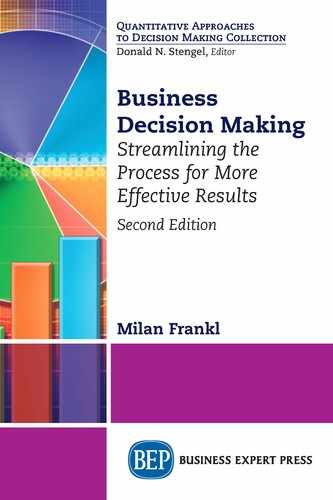Index
Accounts receivable (A/R) policy, 66–67, 109
Actions, 30
Administrative errors, 72
Analysis paralysis syndrome, 90
Associative thinking, 55
Assumptions, verifying, 99–100
Benefit–cost analysis. See Cost/benefit analysis (CBA)
Bottom-up decisions, 40–41
Bounded rationality, 4
Breakeven point, 24
Burnout
defined, 31
warning signs of, 32–33
Business consultants, 41
Business continuity and resiliency planning (BCRP). See Business continuity plans (BCPs)
Business continuity plans (BCPs), 73–75
Business decision making. See Decision making
Business executives
decision making by, 9–12
trust your instinct, 10–11
Business failure
reasons for, 122–123
small, 120–121
statistics, 118–120
Business Intelligence, 53
Business management
constructive change, 13–14
managing errors, 71–75
micromanagement, 81–82
online presence, 29
personal presence, 29–33
planning for, 89–91
positive risk, 36–37
strategic, 91
Business plan. See also Planning
perfect, 117
starting, 118
Business presence management, 29
Canadian Federal Assistance Programs for Small Business, 114
Canadian International Development Agency (CIDA), 113–114
Capital investment decision, 50–52
Caveat emptor, 60–62
Chance, taking, 68–69
Cloud computing, 74
Collaboration, 25–26
Collective wisdom, 55
Complexity
recognizing, 93–94
software function and, 94–95
sources of, 94
useless, 95–96
Computers versus people, 18–19
Constructive change management, 13–14
Contingency planning, 37–38, 77
Cooperative decisions, 41–42
Cost/benefit analysis (CBA), 50–51
Cost–volume–profit (CVP) analysis, 24
Creative thinking, in policy process, 65–66
Critical reflection, 26–27
Customers
demanding, value of, 63
as king, 60–62
with respect, treating, 59–60
Daniel Bernoulli’s Expected Utility Theory, 6
Daniel Kahneman’s Rank Dependent Expected Theory, 6
Data Mining, 53
Data Pattern Recognition systems, 53
Debt at manageable level, keeping, 106–107
Decision making
bottom-up, 40–41
by business executives, 9–12
cooperative, 41–42
delegate, 27–28
early, 14
employees input, 42–43
formal, 2–5
informal, 2–5
by personal experience, 11–12
by theoretical experience, 11
top-down, 40–41
by vicarious experience, 11
Decision-making theories, 6
Defects, 45
Deficient product, 62–63
Delegate decision making, 27–28
Delegation, 83–86
Demanding customers, value of, 63
Disaster recovery plans (DRPs), 73–74
DRIFT principle, 48
Drucker, Peter, 22
Dual process theory, 96
Early decision making, 14
Elusive knowledge, 55
Employees input, 42–43
Employer–Employee Committee (EEC), 42
Enterprise Resource Systems, 53
Entrepreneurship, 88
Erroneous assumptions, 106–107
Error management, 71–75
inconceivable situations, 73–74
person model for, 71
system model for, 71–72
Estimation error, 25–26
Executive Decision Support Systems, 53
Experience, learning from, 26–27
Expert, finding, 52–53
Female workforce, 113–114
Financing, options for, 105–106
Formal decision making, 2–5
Freedom 55, 125–130
Genba walks, 82
Gigerenzer, Gerd, 4
Gist, 12
Good plan, developing, 79
Government, working with, 115
Heuristics, 12. See also Rule of thumb
defined, 1, 5
Hit-and-miss situations, 9
Human error, 71
Inarticulate intelligence, 55
Inconceivable situations, 73–74
Informal decision making, 2–5
Information technology (IT), 18, 20
Internet, 100
ISO 9000, 57
Kahneman, Daniel, 3
Knowing your customer (KYC), 22–23
Knowledge receptors, 57
Knowledge transfer
catalyst, 55
challenge of, 53–56
one-on-one, 54
sausage slicing approach, 56–57
Leadership, key roles of, 28
Learning, from failures, 25–28
Long-range planning, 89, 91
Management behavior complexity, 94
Marketing event, 39–40
Merger fiasco, 1–2
Micromanagement, 81–82
Motivation, 81
Murphy’s law, 75
Mutual sharing, of technology, 74
Numbers, believe in, 49–57
Old Age and Disability Insurance Law, 125
Old-age pension program insurance, 125
One-on-one knowledge transfer, 54
Online presence management, 29
Open communication, 100
Payback period, 50–51
People versus computers, 18–19
Perseverance, 46–47
Person model, for error management, 71
Personal assets out of business, keeping, 107
Personal presence management, 29–33
Planning
for best, 78
contingency, 77
defined, 89–91
good plan, developing, 79
importance of, 87–88
options for, 78–79
past, 88–89
strategic, 88, 91
types of, 89
Positive risk management, 36–37
Premium value, of quality, 45–46
Process and outcome, 17–18
Process complexity, 94
Product complexity, 94
Profit–volume–cost analysis, 24
Project management, 14–15
Prospect Theory, 6
Public Safety Canada (PSC), 74
Quality, premium value of, 45–46
Request for proposal (RFP), 13, 25
Retirement age, 125–126
working beyond, 126–127
Retirement rules, 128
Risk management, positive, 36–37
Risk taking, 108
Rivers and Harbor Act of 1902, 50
Rule of thumb, 12, 50, 108
defined, 1, 5–7
qualitative, 2–4, 51
quantitative, 2–3
Safety, 35–38
Sausage slicing approach, 56–57
Searching, 21–22
September 11, 2011 (9/11), 73, 75
Short-term planning, 89
Simon, Herbert, 3–4
Slow down, 32
Small businesses, failure of, 120–121
Social network, 12
Solutions to problems, 108–110
Strategic management, 91
Strategic planning, 88, 89, 91
Structure complexity, 94
System model, for error management, 71–72
Tacit knowledge level index (TKI), 5
Tacit knowledge transfer, 53–55
relationship with firm’s innovation capability, 55–56
Technology
importance of, 17–20
information, 18, 20
mutual sharing of, 74
as panacea for operational problems, 18
Theoretical experience-based decision making, 11
Thinking process, 96–98
type I, 96–97
type II, 96, 98
Top-down decisions, 40–41
Type I thinking process, 96–97
Type II thinking process, 96, 98
United States Census Bureau
Characteristics of Business Owners Database, 118
Universities cooperation with business, 111–113
U.S. workers’ retirement confidence survey, 127
Useless complexity, 95–96
Vicarious experience-based decision making, 11
Volume, double-edged sword, 23–24
Website, 100–101
usability guidelines, 101–103
Work on weekends, 31–32
Work presence management, 30–31
